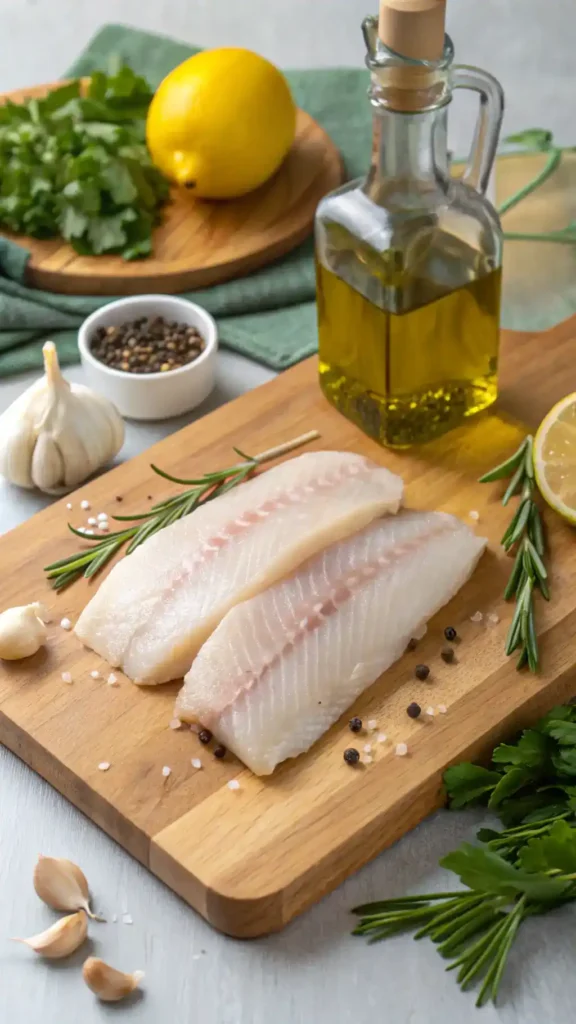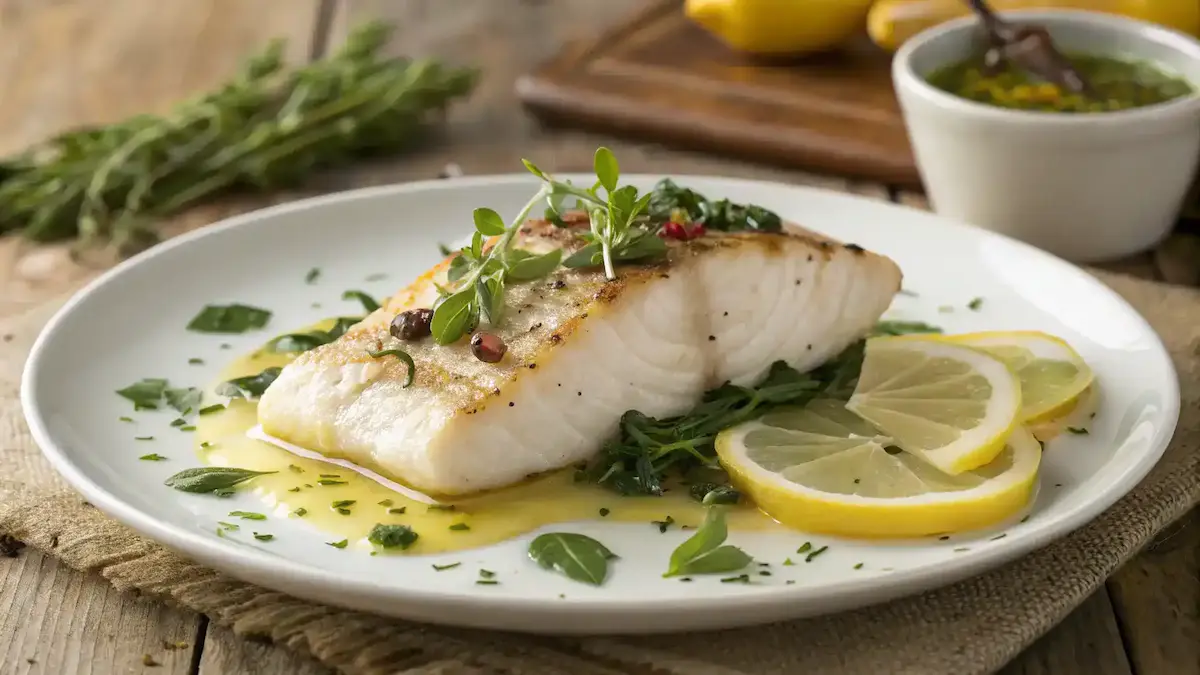If you’re looking for a culinary experience that is both delicious and nutritious, then Chilean Sea Bass is the perfect choice. This fish is not only high in omega-3 fatty acids and protein, but it also boasts a mild, buttery flavor that appeals to a wide range of palates. Moreover, its delicate texture makes it incredibly versatile; you can grill, bake, broil, or pan-sear it to perfection. Additionally, sourcing Chilean Sea Bass from responsible fisheries ensures that you are making a sustainable seafood choice. So, let’s dive into this recipe and explore how to create a flavorful dish that will impress your family and friends!
Table of Contents

Chilean Sea Bass
Equipment
- 1 Baking dish For baking the fish.
- 1 Mixing bowl For marinating the fish.
Ingredients
Fish
- 4 fillets Chilean Sea Bass Fillets Fresh or frozen, ensuring quality for the best flavor.
Cooking Oil
- 2 tablespoons Olive Oil Extra virgin olive oil is ideal for its rich taste.
Acid
- 2 tablespoons Lemon Juice Freshly squeezed for brightness and acidity.
Aromatics
- 3 cloves Garlic Minced, fresh garlic is preferable.
Seasonings
- to taste Salt Use sea salt for a more nuanced flavor.
- to taste Pepper Freshly cracked black pepper for a bit of heat.
Herbs
- to taste Fresh Herbs Parsley, dill, or thyme for garnish.
Instructions
Preparation
- Thaw the fillets if frozen and pat them dry with paper towels.
Marinate
- Combine olive oil, lemon juice, minced garlic, salt, and pepper in a bowl. Let the fillets marinate for at least 30 minutes.
Cooking Method
- Preheat your oven to 400°F (200°C). Place the fillets in a baking dish and bake for 15-20 minutes, or until the fish flakes easily with a fork.
Serving
- Garnish with fresh herbs before serving.
Video
Notes
| Calories | Fat | Protein | Carbs |
|---|---|---|---|
| 200 | 10g | 25g | 0g |
Key Benefits of Chilean Sea Bass
Chilean Sea Bass is not only a culinary delight but also a nutritional powerhouse. Here are some key benefits:
- Health Benefits: High in omega-3 fatty acids, protein, and essential vitamins and minerals, Chilean Sea Bass supports heart health and overall well-being.
- Flavor Profile: With its mild, buttery flavor and delicate texture, Chilean Sea Bass appeals to a wide range of palates, making it a favorite for both novice and experienced cooks.
- Culinary Versatility: You can grill, bake, broil, or pan-sear Chilean Sea Bass, which makes it suitable for various cuisines and cooking styles.
- Sustainability: Sourced from responsible fisheries, Chilean Sea Bass ensures environmental consciousness, allowing you to enjoy your meal guilt-free.
In addition to these benefits, incorporating Chilean Sea Bass into your meals can elevate your cooking experience. For example, its rich flavor enhances any dish, while its nutritional value supports a healthy lifestyle. So, whether you’re preparing a simple weeknight dinner or a special occasion feast, Chilean Sea Bass is a fantastic choice.
Ingredients for Chilean Sea Bass
To prepare the perfect Chilean Sea Bass, gather the following ingredients:
- Chilean Sea Bass Fillets: Fresh or frozen, ensuring quality for the best flavor. Look for fillets that are firm and moist, as this indicates freshness.
- Olive Oil: A healthy fat for cooking that enhances flavor. Extra virgin olive oil is ideal for its rich taste.
- Lemon Juice: Freshly squeezed for brightness and acidity. This will elevate the dish and balance the richness of the fish.
- Garlic: Minced, to add aromatic depth. Fresh garlic is preferable, but you can use garlic powder in a pinch.
- Herbs: Fresh parsley, dill, or thyme for garnish and flavor. These herbs not only enhance the taste but also add a pop of color.
- Salt and Pepper: Essential seasonings to taste. Use sea salt for a more nuanced flavor and freshly cracked black pepper for a bit of heat.

When selecting your Chilean Sea Bass, consider sustainability. Opt for fish sourced from responsible fisheries to support environmental consciousness. Additionally, if you can’t find Chilean Sea Bass, you might substitute it with other white fish like cod or halibut, although the flavor and texture will differ slightly. Overall, using fresh ingredients will significantly enhance your dish, making it a delightful culinary experience.
How to Make Chilean Sea Bass
Cooking Chilean Sea Bass is simple and rewarding. Follow these steps for a perfect dish:
- Preparation: Thaw the fillets if frozen and pat them dry with paper towels. This step is crucial because moisture can prevent a nice sear.
- Marinate: Combine olive oil, lemon juice, minced garlic, salt, and pepper in a bowl. Let the fillets marinate for at least 30 minutes. This allows the flavors to infuse beautifully.
- Cooking Method: Preheat your oven to 400°F (200°C). Place the fillets in a baking dish and bake for 15-20 minutes, or until the fish flakes easily with a fork. Remember, overcooking can lead to dryness, so keep an eye on it!
- Serving: Garnish with fresh herbs before serving. This not only adds flavor but also enhances the dish’s visual appeal.

By following these steps, you’ll create a delicious Chilean Sea Bass that is sure to impress. Enjoy your culinary adventure!
Pro Tips, Variations, and Common Problems
Cooking Chilean Sea Bass can be a delightful experience, but it’s essential to keep a few pro tips in mind to ensure success. Here are some friendly suggestions to elevate your dish:
- Tip: Use a meat thermometer to check for doneness; the internal temperature should reach 145°F (63°C). This ensures your fish is perfectly cooked without being overdone.
- Variations: Experiment with different marinades, such as citrus soy sauce or herb-infused olive oil. For instance, adding a splash of orange juice can enhance the flavor profile beautifully.
- Cooking Methods: Chilean Sea Bass is versatile. You can grill, bake, or pan-sear it. Each method offers a unique texture and flavor, so feel free to try them all!
- Substitutions: If you can’t find Chilean Sea Bass, other white fish like cod or halibut can work well. Just remember that cooking times may vary, so keep an eye on them.
Now, let’s address some common problems you might encounter:
- Overcooking: This can lead to dryness. To avoid this, monitor cooking times closely and check for flakiness.
- Texture Issues: If your fish feels rubbery, it may have been cooked too quickly. Lower the heat and cook it more gently for a tender result.
- Seasoning Problems: If the flavor seems flat, consider adding more salt or a squeeze of lemon juice. Fresh herbs can also brighten the dish significantly.
By keeping these tips and variations in mind, you’ll be well on your way to creating a delicious Chilean Sea Bass dish that impresses everyone at your table!
Serving Suggestions for Chilean Sea Bass
When it comes to serving Chilean Sea Bass, the presentation can elevate your dish from delicious to truly memorable. This fish, known for its mild, buttery flavor and delicate texture, deserves to be showcased beautifully. Here are some engaging serving suggestions that will impress your guests and enhance your dining experience.
Plating Ideas
To create a visually appealing plate, consider the following tips:
- Use a large, white plate to make the colors of the fish and sides pop.
- Place the Chilean Sea Bass fillet slightly off-center, allowing room for garnishes.
- Drizzle a vibrant sauce, like a lemon butter sauce, around the fish for added color and flavor.
Side Dish Pairings
Chilean Sea Bass pairs beautifully with a variety of sides. Here are some options:
- Roasted seasonal vegetables, such as asparagus or Brussels sprouts, add a lovely crunch.
- Quinoa or wild rice provides a nutty flavor and complements the fish’s richness.
- A fresh salad with mixed greens, cherry tomatoes, and a light vinaigrette offers a refreshing contrast.
Creative Serving Options
Depending on the occasion, you can serve Chilean Sea Bass in different styles:
- For a casual gathering, serve the fish family-style on a large platter, surrounded by sides.
- For an elegant dinner, plate each fillet individually with artistic garnishes.
- Consider a tapas-style presentation with small portions of Chilean Sea Bass alongside various dipping sauces.
Presentation Tips
To enhance the overall dining experience, keep these presentation tips in mind:
- Garnish with fresh herbs like parsley or dill for a pop of color and freshness.
- Add lemon wedges on the side for a zesty touch and to encourage guests to customize their flavor.
- Consider using edible flowers or microgreens for an upscale look.
By thoughtfully considering how you serve Chilean Sea Bass, you not only enhance its appeal but also create a delightful dining experience. Whether you choose a casual or elegant setting, your guests will surely be impressed by both the presentation and the delicious flavors of this sustainable seafood choice.
Preserving and Reheating Chilean Sea Bass
To maintain the quality of your Chilean Sea Bass, proper storage and reheating techniques are essential. Firstly, when it comes to storage, you want to ensure that your fish stays fresh and flavorful. Store leftover Chilean Sea Bass in an airtight container in the refrigerator for up to 3 days. If you need to keep it longer, freezing is a great option. Cooked fillets can be frozen for up to 2 months. Just remember to thaw them in the refrigerator before reheating. Additionally, always prioritize food safety Food Safety by ensuring your fish is cooled to room temperature before sealing it away. This helps prevent bacterial growth and spoilage.
Reheating Methods
Now, let’s talk about reheating your Chilean Sea Bass without sacrificing its delicious flavor and delicate texture. The oven is one of the best methods for reheating. Preheat your oven to 275°F (135°C). Place the fillets in a baking dish and cover them with aluminum foil to retain moisture. Heat for about 15-20 minutes, or until warmed through. Alternatively, you can use the stovetop. Simply add a splash of olive oil to a skillet over low heat, then gently reheat the fish for about 5 minutes on each side. This method not only warms the fish but also adds a touch of flavor. If you’re in a hurry, the microwave can be used, but be cautious. Place the fish on a microwave-safe plate, cover it with a damp paper towel, and heat in 30-second intervals until warm. However, this method may not yield the best texture.
For an extra touch, consider adding a bit of moisture while reheating. A squeeze of fresh lemon juice or a drizzle of olive oil can enhance the flavor and keep the fish from drying out. Remember, the key is to reheat slowly and gently, ensuring your Chilean Sea Bass remains as delightful as when it was first cooked.
Conclusion
In summary, cooking Chilean Sea Bass is a delightful experience that combines simplicity with impressive results. By following the straightforward steps of marinating, baking, and garnishing, you can create a dish that not only tastes fantastic but also showcases the fish’s mild, buttery flavor. This recipe is versatile, allowing you to experiment with different cooking methods and flavor enhancements, making it a perfect choice for both novice and seasoned cooks alike. So, gather your fresh ingredients, and don’t hesitate to dive into this culinary adventure!
Share Your Experience
We would love to hear about your cooking journey! Feel free to share your results or ask any questions you may have. Additionally, consider trying out various marinades or side dishes to personalize your meal. Remember, cooking is all about creativity and enjoyment, and Chilean Sea Bass offers a wonderful canvas for your culinary expression. So, get in the kitchen, have fun, and savor the deliciousness of your homemade dish!
FAQs about Chilean Sea Bass
Here are some common questions about cooking and enjoying Chilean Sea Bass, along with helpful answers to enhance your culinary experience.
What is the best way to cook Chilean Sea Bass?
The best methods include baking, grilling, and pan-searing. Each technique brings out the mild, buttery flavor of the fish. For instance, baking at 400°F (200°C) for 15-20 minutes yields a tender texture.
Can I substitute Chilean Sea Bass with another fish?
Yes, you can use other white fish like cod or halibut. However, keep in mind that cooking times may vary. Thus, monitor the fish closely to ensure it remains moist and flavorful.
How do I know when my Chilean Sea Bass is cooked?
Chilean Sea Bass is perfectly cooked when it flakes easily with a fork and reaches an internal temperature of 145°F (63°C). Using a meat thermometer is a great way to check for doneness.
Is Chilean Sea Bass sustainable?
Yes, Chilean Sea Bass can be sourced from responsible fisheries. When purchasing, look for certifications that indicate sustainable seafood practices. This ensures you are making an environmentally conscious choice.
What are some good side dishes to serve with Chilean Sea Bass?
Chilean Sea Bass pairs beautifully with roasted vegetables, quinoa, or a fresh salad. Additionally, consider sauces like lemon butter or tomato basil salsa to enhance the dish’s flavor.

